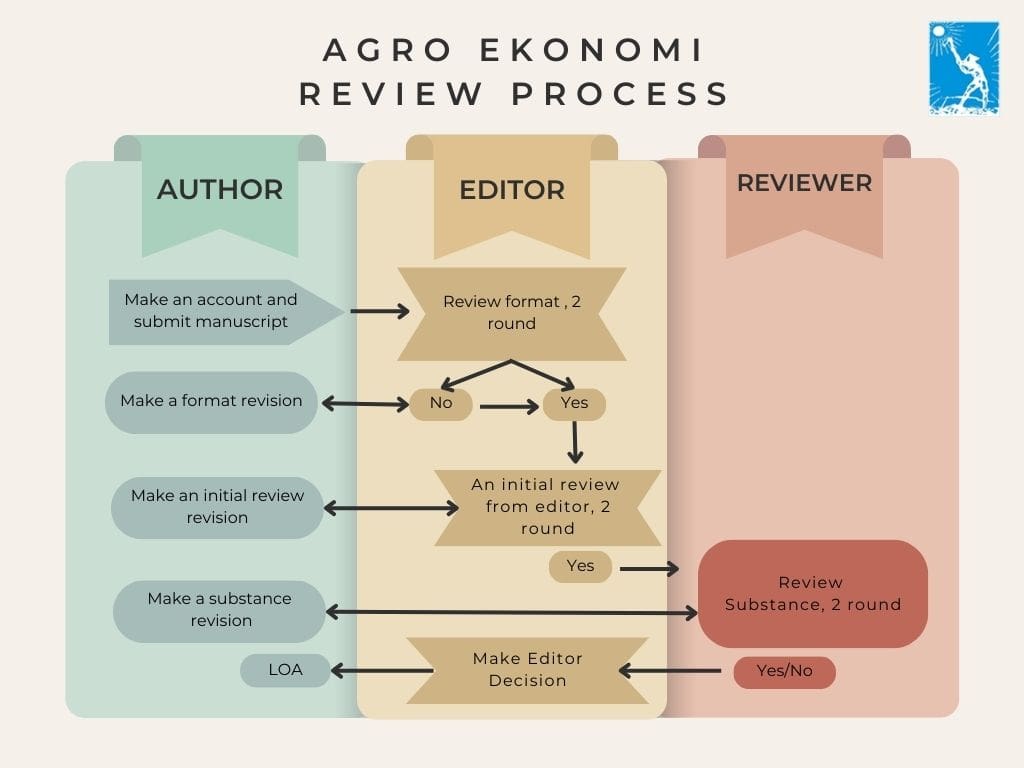Technical Efficiency of State-Owned Sugarcane Production in East Java
Muhammad Taufik Yusuf(1*), Jamhari Jamhari(2), Irham Irham(3)
(1) Department of Agricultural Socio-Economics, Faculty of Agriculture, Universitas Gadjah Mada and PTPN XI, Surabaya
(2) Department of Agricultural Socio-Economics, Faculty of Agriculture, Universitas Gadjah Mada
(3) Department of Agricultural Socio-Economics, Faculty of Agriculture, Universitas Gadjah Mada
(*) Corresponding Author
Abstract
This study aims to (1) identify the factors that influence the production of plant cane and ratoon cane, (2) determine the level of production efficiency of plant cane, ratoon cane, and poll, and (3) identify the factors that influence the inefficiency of plant cane and ratoon cane production. The data used was secondary data sourced from the production data for the 2017-2018 planting season with some inputs: land area, fertilizers, herbicides, labor, age of plants harvested and data of land types. From the analysis, it was revealed that (1) factors influencing the increase of plant cane production were land area, ZA fertilizer, harvest labor, and types of fields. Meanwhile, the influential factors impacting the increase of ratoon cane were land area, SP36 fertilizer, ametryn herbicide, harvest labor, type of fields, and HGU land type while estate labor, mechanization, and dummy varieties affect decreasing on it, (2) sugarcane farming was technically efficient (3) factors affecting the inefficiency for plant cane are formal education and rank levels of plant officer. However the coefficient of the formal education variable was negative and the rank level coefficient was positive. A higher level of education will increase production, but a higher rank level of plant officer will decrease it. Improving education levels can be provided by giving mentoring or the provision of courses. In ratoon cane, there was no effect of technical inefficiency. So an increase in ratoon cane production can be done by increasing the use of production inputs.
Keywords
Full Text:
PDFReferences
Battese, G. E., & Corra, G. S. (1977). Estimation of a Production Frontier Model: With Application To the Pastoral Zone of Eastern Australia. Australian Journal of Agricultural Economics, 21(3), 169–179. https://doi.org/10.1111/j.1467-8489.1977.tb00204.x
Coelli, T. J. (1996). A Guide to FRONTIER Version 4.1: A Computer Program for Stochastic Frontier Production and Cost Function Estimation. CEPA Working Papers, 7, 1–33. https://doi.org/10.1007/BF00158774
Coelli, T. J., Rao., D. S. P., & Battese, G. E. (1998). An Introduction to Efficiency and Productivity Analysis. Boston: Kluwer Academic Publishers.
Coelli, T. J., Rao., D. S. P., O’Donnel, C. J., & Batesse, G. E. (2005). An Introduction to Efficiency and Productivity Analysis. Second edition (2nd ed.). New York: Springer Science-i-Business Media, Inc.
Fahriyah, F., Hanani, N., Koestiono, D., & Syafrial, S. (2018). Analisis Efisiensi Teknis Usahatani Tebu Lahan Sawah dan Lahan Kering dengan Pendekatan Data Envelopment Analysis (DEA). Jurnal Ekonomi Pertanian Dan Agribisnis (JEPA), 2(1), 77–83. https://doi.org/10.21776/ub.jepa.2018.002.01.8
Febrianti, D. I., Jamhari, J., & Hartono, S. (2015). Efisiensi Usaha Tani Tebu di Kabupaten Purworejo. Jurnal Agro Ekonomi, 26(1), 1–9.
Gideon, A. (2019). Rendahnya Produktivitas Tebu Bikin Impor Gula Melambung. Retrieved December 23, 2019, from liputan6.com website: https://www.liputan6.com/bisnis/read/3875078/rendahnya-produktivitas-tebu-bikin-impor-gula-melambung
Jain, R., Solomon, S., Shrivastava, A. K., & Chandra, A. (2010). Sugarcane bud chips: A promising seed material. Sugar Tech, 12(1), 67–69. https://doi.org/10.1007/s12355-010-0013-9
Kadarwati, F. T., Santoso, B., & Khuluq, A. D. (2015). Peningkatan Produksi dan Rendemen Tebu Melalui Rawat Ratoon. Jurnal Litri, 21(4), 199–205.
Kementerian Pertanian. (2016). Outlook Tebu. Pusat Data Dan Sistem Informasi Pertanian, 84.
Mastur, M. (2016). Respon Fisiologis Tanaman Tebu Terhadap Kekeringan. Buletin Tanaman Tembakau, Serat & Minyak Industri, 8(2), 98–111. https://doi.org/10.21082/btsm.v8n2.2016.99-112
Mazwan, M. Z., & Masyhuri, M. (2019). Alokasi Penggunaan Input Produksi Tebu Perkebunan Rakyat di Jawa Timur (Studi Kasus Petani Tebu Plasma PTPN XI). Jurnal Ekonomi Pertanian Dan Agribisnis (JEPA), 3(1), 138–151. https://doi.org/10.21776/ub.jepa.2019.003.01.14
Nusantara Sugar Community. (2017). Jurnal Gula. 51(7), 62.
Pakpahan, F. P., & Purwono, P. (2018). Pengelolaan Tanaman Tebu (Saccharum officinarum L.) di Wilayah PG Madukismo dengan Aspek Korelasi Pemupukan terhadap Produktivitas. Buletin Agrohorti, 6(3), 336–343. https://doi.org/10.1017/CBO9781107415324.004
Puruhito, D. D., Jamhari, J., Hartono, S., & Irham, I. (2019). Technical Efficiency and Sources of Inefficiency in Smallholder Oil Palm Plantation in North Mamuju District, West Sulawesi Province, Indonesia. American-Eurasian Journal of Sustainable Agriculture, 13(1), 1–8. https://doi.org/10.22587/aejsa.2019.13.1.1
Puspitasari, K., Sebayang, H. T., & Guritno, B. (2013). Pengaruh Aplikasi Herbisida Ametrin Dan 2 , 4-D Dalam Mengendalikan Gulma Tanaman Tebu ( Saccharum Officinarum L .). Jurnal Produksi Tanaman, 1(2), 72–80.
Riajaya, P. D., & Kadarwati, F. T. (2016). Kesesuaian Tipe Kemasakan Varietas Tebu pada Tipologi Lahan Bertekstur Berat, Tadah Hujan, dan Drainase Lancar. Buletin Tanaman Tembakau, Serat & Minyak Industri, 8(2), 85–97.
Setyawati, I. K., & Wibowo, R. (2019). Efisiensi Teknis Produksi Usahatani Tebu Plant Cane dan Tebu Ratoon Cane (Studi Kasus di PT. Perkebunan Nusantara X). Journal of Social and Agricultural Economics (JSEP), 12(1), 80–99.
Susilowati, S. H., & Tinaprilla, N. (2012). Analisis Efisiensi Usaha Tani Tebu Di Jawa Timur. Jurnal Littri, 18(4), 162–172. https://doi.org/10.21082/littri.v18n4.2012.162
Tinaprilla, N. (2011). Analisis Efisiensi Teknis Usahatani Tebu Di Jawa Timur. In R. Nurmalina, W. B. Priatna, S. Jahroh, P. Nurhayati, & A. Rifin (Eds.), Prosiding Seminar - Penelitian Unggulan Departemen Agribisnis (pp. 51–78). Bogor: Departemen Agribisnis Fakultas Ekonomi dan Manajemen Institut Pertanian Bogor.
Zainuddin, A., & Wibowo, R. (2018). Analisis Potensi Produksi Tebu dengan Pendekatan Fungsi Produksi Frontir di PT Perkebunan Nusantara X. Jurnal Pangan, 27(1), 33–42. Retrieved from http://www.jurnalpangan.com/index.php/pangan/article/view/404%09
Article Metrics
Refbacks
- There are currently no refbacks.
Copyright (c) 2018 Agro Ekonomi

This work is licensed under a Creative Commons Attribution-ShareAlike 4.0 International License.
View My Stats











